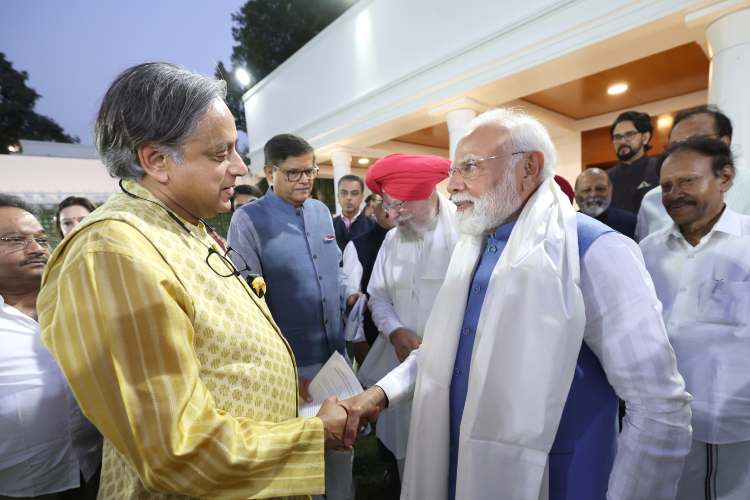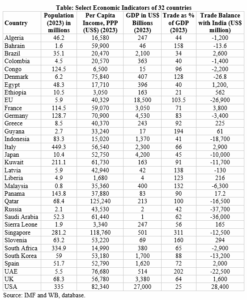
Indian diplomacy key to economic ambitions: In the twenty-first century, power no longer flows solely from military might—it flows from economic clout, technological edge, and the ability to build lasting partnerships. The modern international order, increasingly shaped by interdependence, hinges on a simple but demanding principle: cooperate or fall behind. From resilient supply chains and climate coordination to digital public infrastructure and trade realignment, the new global commons is economic.
The United States, still the world’s largest economy, has long asserted that diplomacy must be guided by economics. That message has gained fresh urgency as countries scramble to recalibrate their strategic priorities amid economic fragmentation, energy volatility, and technological disruption. Multilateral institutions continue to nudge nations toward a time-bound consensus on global challenges. But more often than not, the real breakthroughs are bilateral—painstakingly brokered through trade corridors, investment treaties, and knowledge-sharing platforms.
Against this backdrop, India has stepped up its diplomatic game—not with sabre-rattling or bombast, but with intent, engagement, and economic ambition.
READ | India’s drug abuse crisis hits alarming proportions
Diplomacy key to sustained growth
Any country that has made the leap to prosperity in recent decades—South Korea, China, Vietnam—has first secured a peaceful domestic environment. For a continent-sized India, with 1.4 billion people, multiple faiths, hundreds of languages, and deep regional diversity, peace is not just a virtue; it is a precondition for inclusive growth.
India now contributes nearly one-sixth of humanity and plays a crucial role in the economic output of host countries through its diaspora. As it races toward becoming the world’s third-largest economy by the end of this decade, India’s internal stability and external engagement become pivotal—not only for itself but for the broader South Asian region and the world.
The recent flare-up in Kashmir, reportedly backed by cross-border forces, underscores the threat to this trajectory. India’s swift yet measured response—including a short, calibrated retaliation followed by a ceasefire—signals a strategic doctrine rooted not in perpetual confrontation but in protecting economic momentum.
Indian diplomacy and 32 country outreach
It is in this context that India’s decision to dispatch high-level delegations to 32 strategically selected nations must be understood. These missions span energy-exporting Gulf economies like Saudi Arabia and Kuwait, innovation leaders such as Japan and Germany, ASEAN neighbours with whom food and digital security can be jointly pursued, and resource-rich Latin American nations critical to India’s mining and critical minerals strategy.

This is not a vanity tour. It is a clear-headed investment in relationships that will secure India’s access to energy, semiconductors, palm oil, electric vehicle components, green hydrogen know-how, and high-tech capital. In short, it is economic diplomacy on steroids.
However, what was lacking—and must now be corrected—is the absence of domain experts in these delegations. Had economists, sectoral specialists, and investment strategists been embedded within each team, the political goodwill generated could have been converted into actionable economic blueprints. It is not too late.
Empowering economic frontline
India’s embassies and High Commissions already house economic and trade ministers. But these posts often remain underutilised, their mandate unclear, and coordination with home ministries patchy. This must change.
These officers are India’s economic frontline in foreign capitals. They must be empowered—not merely to handle red tape but to initiate sector-specific dialogues, arrange B2B interactions, and chase opportunities that align with India’s strategic growth goals.
Simultaneously, India must activate the mirror image of this strategy within its borders. The trade envoys of these 32 nations, stationed in New Delhi, should be invited for structured policy discussions—not in silos but through an India+1 framework that showcases areas of mutual gain: green manufacturing, medical tourism, digital infrastructure, renewable energy, and more.
For instance, with Indonesia and Malaysia, India must secure palm oil trade through long-term agreements while linking this to downstream food processing investments in India. Europe offers ripe prospects for free trade agreements—especially with the EU’s push for resilient supply chains. And Latin America holds the key to India’s ambitions in lithium and rare earth minerals.
These relationships must move from symbolism to structure—from diplomacy to delivery.
Viksit Bharat: From rhetoric to roadmap
The endgame is clear. India is not looking to dominate; it seeks to rise—peacefully, purposefully, and inclusively. With a 5,000-year civilizational legacy, India once accounted for more than a quarter of the world’s GDP. While that past glory is not a blueprint, it is a reminder that India is no stranger to global leadership.
Today, India is in the middle of a rare demographic window. For the next 20 years, it will have the largest working-age population in the world. If India plays its cards right—by skilling its workforce, upgrading its logistics, and embedding itself in global value chains—it can aim for a per capita income of $17,000 by 2047, its 100th year of independence.
This is the target of Viksit Bharat. No other democracy has articulated such a long-term vision with such granularity. India is, quite literally, attempting to do what Arjun did in the Mahabharata: block out all distractions and focus on the eye of the fish.
But diplomacy must support this ambition. The recent outreach to 32 countries must not end with press releases or protocol photographs. It must become the scaffolding on which India builds its global economic presence—strong, stable, and sustainable.
Growth as strategic doctrine
India’s response to provocations, its 25-year development plan, and its push for international consensus through strategic diplomacy are not separate stories. They are chapters of a larger narrative: that India is a peace-loving, growth-hungry nation determined to reshape its destiny—not through coercion, but through collaboration.
If India stays the course, its rise will not only benefit its citizens but also offer the world a model of pluralistic prosperity in an age of polarisation. That, ultimately, is the most powerful message India can send.
Dr Charan Sigh is a Delhi-based economist. He is the chief executive of EGROW Foundation, a Noida-based think tank, and former Non Executive Chairman of Punjab & Sind Bank. He has served as RBI Chair professor at the Indian Institute of Management, Bangalore.

